What is a Plasma?
advertisement
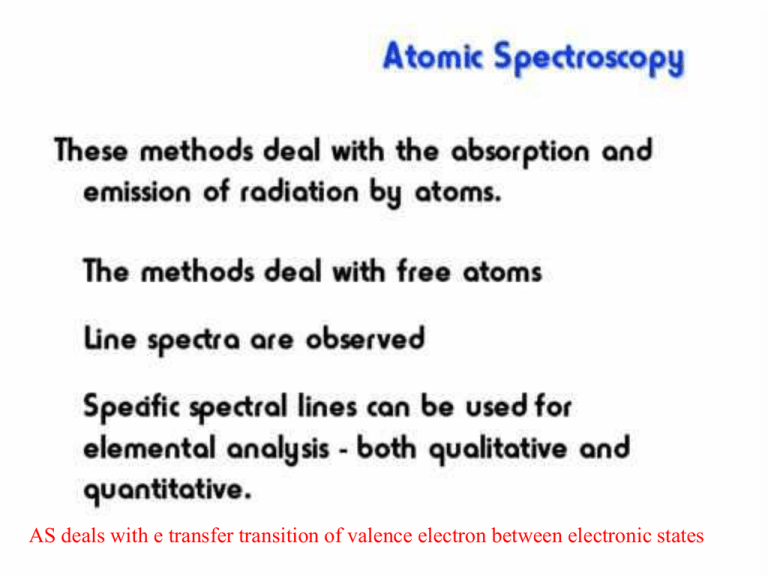
AS deals with e transfer transition of valence electron between electronic states AAS I0 A:absorbance I A = - log T = - log( I / I ) T:transmittance = εbC C:conc. o AC 吸收值與濃度呈線性關係 b:path length AFS Light source 於P0°角看放出之螢 光 (P0°乃因有散射) ε:absorpivity hν ΦL = k′Φ0C ΦL C Φ0 hν 螢光源與入射光頂角成 正比,且與濃度成正比 AES 激發態原子不穩定會降到ground state,而以光的形式放出,放出之光的強度與 處於激發態的原子數目有關 (波茲曼係數) Ej Ei E = A ji h ji n jV E n j Nj/Ni = Pj*e-ΔEi/kT/Pi Temperature effect on the atomic spectra Boltzmann equation Nj/N0 = gj/g0 * exp(ΔE/RT) AA吸收希望atoms在ground state, AES溫度要高,在excited state’s atoms or ions ↑. Spectral line intensity 原子在excited愈多,強度愈高 (僅電流多點即可) Iem 當conc.很低時,conc. ↑或原子在excited增加,則 intensity會增強,最後不再增強而變寬 變寬效應 λ ∴Iem C (但不會無限制增加) Sequential ICP-AES Instrumentation Major Components of ICPAES Sample Delivery System - pump, nebulizer, spray chamber Inductively Coupled Plasma - torch, RF generator Spectrometer - Monochrometer, photomultiplier tube Sample Delivery System Nebulizer: Concentric-tube pneumatic nebulizer • converts sample to aerosol by a jet of gas (compressed Ar) Common types: •Pneumatic - concentric tube, cross flow Cross flow nebulizer •Ultrasonic Ultrasonic nebulizer with desolvation Inductively Coupled Plasma What is a Plasma? •Plasma source provides atomization •Plasma: “a gas-like phase of matter that consists of charged particles” •ICP-AES plasma source is from the carrier gas Typically argon is used Drawback • Solid and liquid samples must be prepared so that they can be easily evaporated and ionized by the instrument1 • ICP-AES is a destructive technique, but only a small bit of sample is necessary • Sample introduction into the instrument: the thorn in the side of ICP-AES Plasma • Plasma source provides atomization • Plasma: “a gas-like phase of matter that consists of charged particles”2 • ICP-AES plasma source is from the carrier gas Inductively coupled plasma (ICP) …torch design… Radiofrequency Generator ICP torch ICP temperatures Detection 2 Types of Detection Positions: 1. Radial Viewing 2. Axial Viewing Radial Viewing Characteristics of the ICP 1. High Temp. 2. Long residence times. 3. High electron number densities(few ionization interferences) 4. Free atoms formed in nearly chemically inert environment. 5. Molecular species absent or present at low levels. 6. Optical thin. 7. No electrodes. 8. No explosive gas. How to perform Simultaneous Analysis • Simultaneous analysis was carried out until today by using: – polychromators, which are Paschen-Runge optics coupled to high sensitivity detectors known as Photomultiplers (PMT) – Echelle-Grating optics, coupled to Solid State Detectors , (CCD, SCD & CID types), also known as Charge Transfer Devices (CTD’s) Detail of a Paschen-Runge optics with PMT detectors Optical Fibers Photo multipliers Diffraction Grating Advantages: Grating Rowland circle Entrance slit High light throughput Wide spectral range Few optical components Low stray light level Robust Exit slits Photomultiplier Tubes Photographic Film X Y PMT SCANNING + PMT Optics and Detectors Typical Echellogram ICP optical emission spectrometry ICP-OES • Capable of true simultaneous multielement analysis • Minimal chemical interferences • Spectral interferences overcome with use of alternate lines or intensity corrections on either side of analytical line • Axial and side-on viewing systems available ICP-OES operation • Variety of sample introduction approaches available (pneumatic nebulizer with ~ 1 mL/min uptake is most common) • Sensitivities better than FAA and often comparable with GFAA when using axial viewing • Varying degrees of automation available Background Noise Sources • Argon emission lines • Carbon and silicon lines • Oscillation by the plasma itself and oscillations caused during aerosol production and sample delivery Such intensities are practically constant and easily recognized Poor Detection Limits on Certain Trace Elements • Examples of interferences include: • • • • 40Ar16O on the determination of 56Fe 38ArH on the determination of 39K 40Ar on the determination of 40Ca 40Ar40Ar on the determination of 80Se • Solution: the cold/cool plasma Limits of Detection Decrease in limits of detection over the course of time using examples of Perkinelmer ICP emission Spectrometers ICP/5000 (1980), Optima 3000 (1993), Optima 3000 XL (1997) All detection limits were determined by the blank method using the statistical factor K = 3 [concentrations in ppb] As 193 Cd 214 Cr 267 Ni 231 Pb 220 Zn 231 1980 radial 150 3 5 10 50 2 1993 radial 50 2 2 5 10 1 1997 axial 5 0.3 0.2 0.7 0.8 0.1 DCP Inductively coupled plasma mass spectrometry ICPMS ICPMS characteristics • “Simultaneous” multielemental analysis • 5-6 orders of magnitude in dynamic range(need fewer standards for calibration) • ppt and even ppq LODs available • Isotopic information available • Spectral interferences occur and involve polyatomic ions or isotopes of other elements • Interferences involving ion optics (e.g., “space charge”) and ionization efficiency are unique to ICPMS




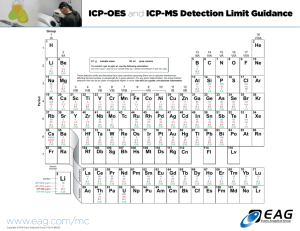


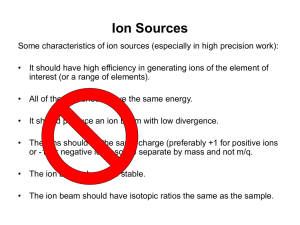
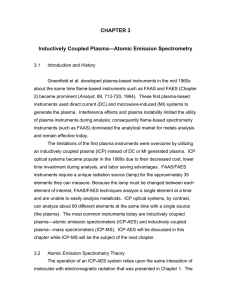
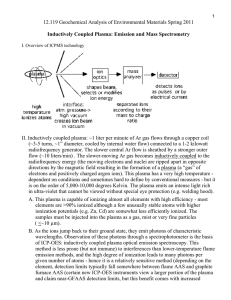
![[HOU JONES] ICP OES](http://s3.studylib.net/store/data/025244484_1-8fbed401eaf7e69f143f81bc6e93bb70-300x300.png)